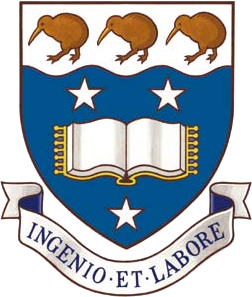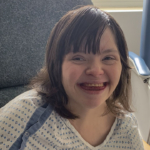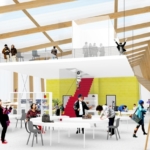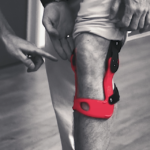Vibration therapy improves mobility and strength in young people with cerebral palsy
Young adults with cerebral palsy enjoy stronger bones and greater mobility after training on a specialised vibration plate.

Mobility-enhancing care in CP helps strengthen bones. Kids at the Atlanta center work on improving motor function and functional performance. Children’s Healthcare of Atlanta photo.
by Nicola Shepheard, The University of Auckland March 10, 2016
The young adults were participating in a clinical trial of the whole-body vibration training by the Liggins Institute at the University of Auckland. A paper about the study is now published online in Scientific Reports from Nature Publishing Group.
In the trial, 40 young people with cerebral palsy, aged 11 to 20, stood on a specially designed vibration plate for nine minutes a day, four times a week. After 20 weeks of training, researchers found multiple benefits.
Liggins Research Fellow Dr Silmara Gusso, who led the study, said some participants showed dramatic improvements.
“We expected them to increase their bone mass and muscle mass, which is what happened. What we didn’t expect was that their day-to-day functioning would also improve.
“Some kids were walking 30 per cent further in a 6-minute walk test – that might not sound much for us, but being able to walk an extra 100m is huge for them. The feedback from parents and carers about the changes they were noticing was especially encouraging: improved mood, greater manoeuvrability and fewer falls. In a group with troublesome constipation vibration therapy was also unexpectedly beneficial.
“Parents and physios saw not only physical but also emotional changes. Confidence improved: kids who used to walk around holding onto rails are now walking around the school with their chins up.”
| Cerebral palsy is the most common cause of physical disability in childhood, yet treatments to relieve the effects are limited. Cerebral palsy affects movement control which over the years impacts muscle and bone health. However, in a unique trial at the Liggins Institute’s Clinical Research Unit, research fellow Dr Silmara Gusso discovered huge improvements in children with cerebral palsy who used a vibration plate for just a few minutes a day. In this presentation she explains how the clinical trial worked and some of the biggest breakthroughs for participants. University of Auckland. Youtube Dec 19, 2016 |
Cerebral palsy, a group of movement disorders, is the most common cause of physical disability in childhood. It affects 2 in 1000 children, and usually appears at birth or in early infancy. It’s caused by abnormal development or damage to parts of the brain that control movement, balance and posture. Children with the disorders have impaired muscle function and reduced muscle and bone mass. Muscles that normally work in complementary action will simultaneously go into spasm, making movement difficult, and over time the muscles waste. About half of children have a higher-than-normal risk of bone fractures, partly because their muscles aren’t pulling on their bones in the normal way to promote healthy bone development.
Until now, treatments to relieve the disorders’ effects have been fairly limited: injection of botox, surgery, passive stretching by physiotherapists and injection of bisphosphonates to increase bone density.
Previous, small-scale studies had indicated that Whole Body Vibration Training (WBVT) offered benefits for young people with cerebral palsy. This trial, the biggest and most rigorous to date, confirms and elaborates on the benefits.

Children’s Healthcare of Atlanta
The trial used a vibration plate that has been specially developed and tested for physical therapy. Patients stand on it barefoot, holding onto its metal frame for support if necessary. Its see-saw movement stimulates a pattern similar to walking. This is thought to improve communication between the muscles and spine, thereby aiding balance and co-ordination.
Gusso and her team at the Liggins Institute are now conducting follow-up trials to ascertain the best training regime for optimal, ongoing gains, and to investigate potential benefits for people with more severe cerebral palsy, and people with other disorders.
The researchers hope WBVT will be introduced into all physical therapy sites across the country.
Said Gusso: “It’s something simple that can help a lot of kids.”
| Jubilee Crippled Children Foundation Trust and the Sir David Levene Foundation funded the research. |
 Source The University of Auckland
Source The University of Auckland
| References |
Effects of whole-body vibration training on physical function, bone and muscle mass in adolescents and young adults with cerebral palsy, Silmara Gusso, Craig F Munns, Patrícia Colle, José G B Derraik, Janene B Biggs, Wayne S Cutfield & Paul L Hofman. Scientific Reports 6, Article number: 22518 (2016) doi:10.1038/srep22518
| Further reading |
Alleviation of Motor Impairments in Patients with Cerebral Palsy: Acute Effects of Whole-body Vibration on Stretch Reflex Response, Voluntary Muscle Activation and Mobility, Krause A, Schönau E, Gollhofer A, Duran I, Ferrari-Malik A, Freyler K, Ritzmann R. Front Neurol. 2017 Aug 16;8:416. doi: 10.3389/fneur.2017.00416. eCollection 2017.
Acute corticospinal and spinal modulation after whole body vibration, A. Krause, A. Gollhofer, K. Freyler, L. Jablonka, and R. Ritzmann. J Musculoskelet Neuronal Interact. 2016 Dec; 16(4): 327–338.
Effects of Three Weeks of Whole-Body Vibration Training on Joint-Position Sense, Balance, and Gait in Children with Cerebral Palsy: A Randomized Controlled Study, Ko MS, Sim YJ, Kim DH, Jeon HS. Physiother Can. 2016;68(2):99-105.
Also see
Whole-body Vibration Research Reduces Falls, Helps MS Symptoms University of Texas at El Paso, Stanley E. Fulton Biomechanics and Motor Behavior Laboratory
Mobility-enhancing care in CP helps strengthen bones Lower Extremity Review
Family seeks new remedy for son with cerebral palsy The Bend Bulletin






